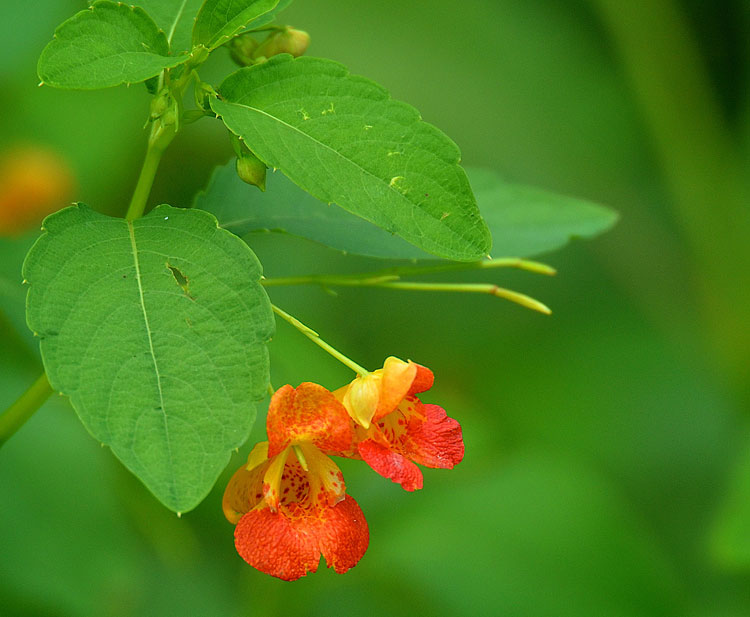 |
| A Spotted Jewelweed flower dangles from a translucent green stem. This beautiful flower is a powerhouse of fuel for the Ruby-throated Hummingbird during fall migration. |
A hummingbird's horn of plenty...
Spotted Jewelweed's conical horn-shaped flower with its tubular nectar spur was made for hummingbirds, literally. The flower coevolved with hummingbirds and is the main nectar source for the tiny bird on its return flight south in late summer and early fall (jewelweed blooms well into October). In return, the hummingbird is the flower's main pollinator. The downward angle of the nectar spur forces the hummingbird to go deeper into the flower to reach the nectar, which means more pollen ends up on the hummingbird's head, ensuring pollination and making the hummingbird a very efficient pollinator. To learn more about nectar spurs and pollinators, click here for the article, "The relationship between nectar spur curvature in jewelweed (Impatiens capensis) and pollen removal by hummingbird pollinators," by Steven Travers, Ethan Temeles, and Irvin Pan.
 |
| When you look at Spotted Jewelweed in profile, you can see how its horn-of-plenty shape and the small tubular spur at the base of the flower that holds nectar is perfect for a hummingbird. |
Disperses seeds like a pro...
Jewelweed's common name, Touch-me-not, comes from its unusual method of seed dispersal. When the seed pods ripen, the slightest touch (even that of a strong breeze) triggers a pop that ejects the seeds up to four feet away. Unlike most wildflowers, Jewelweed is an annual, not a perennial, which means its only way to reproduce is through seed. Efficient seed dispersal is critical to its survival, so it's no surprise it has developed such a cool method of ensuring its seeds get distributed. In addition to jewelweed's showy horn-shaped flower, another type of flower called a cleistogamous flower contributes to seed production. This flower is inconspicuous, small and green, and it never opens. It is self pollinated, and when it ripens, the seeds are not thrown as far. Botanists assume this ensures some seeds stick close to the parent plant where they will thrive in the same habitat. The seeds from the pollinated flowers come from genes from two parents and are more likely to be able to survive in conditions that might be slightly different, so they are tossed far and wide. Additionally, it's scientific name of "Inpatiens" derives from this "impatient" explosion of seeds. Source: "The Book of Swamp and Bog; Trees, Shrubs, and Wildflowers of Eastern Freshwater Wetlands," by John Eastman, pgs 91-95. (p.s. This book is part of a series of three. The other two are "Forest and Thicket" and "Field and Roadside." I love them because they go into detail with lots of interesting tid bits!)
 |
| The deep oranges and reds of Spotted Jewelweed are a preview of the warm colors of autumn. It's a perfect transition flower from summer to fall. |
 |
| ...if you want to wax whimsical, this little flower could totally be a hat for a little flower fairy or gnome. Too cute! |
I used to think jewelweed was named for its jewel-toned orange and yellow colors, but it's not. Several years ago, I photographed the yellow-colored jewelweed (Impatiens pallida), and after researching it, I learned the moniker referred to the leaves. When water droplets form on the leaves, they shine like tiny, sparkling jewels, and when the leaves are placed under water, the underside shines like silver. Click here to see photos of Yellow Jewelweed (Pale Touch-me-not). The post also covers its use as an antidote for stinging nettle burns, poison ivy rashes, and mosquito bites!











8 comments:
Love these compositions.
Nicely done.
Very beautiful flower--I don't know if we don't have them here, or if I've not noticed them!
I'll have to keep an eye out.
Nice pictures.. Have a great week..
oh my, a gem indeed! most our flowers are gone now, just finding a few here and there. I will miss them.
Heh, heh! Great minds think alike; I just put up a post about Summer fading into Fall yesterday on my blog, and it included Jewelweed. (Cue the music from Twilight Zone!)
@Rick - Thank you! :-)
@Sue - Look for them around creeks, rivers, ponds and lakes, and in wet ditches or roadsides...wet woods...in other words, near water! :-)
@Ana - Thanks, Ana! You too!
@Tammie - I will too...these hold out well into October, along with asters. It will be sad to say goodbye to all of the flowers.
@Roy - hahaha! I hear the music! I'll have to pop over to read your post!
Love the color. I don't think I have ever seen that wild flower. So beautiful.
@Janice - it is a gorgeous color! I love it too.
Post a Comment